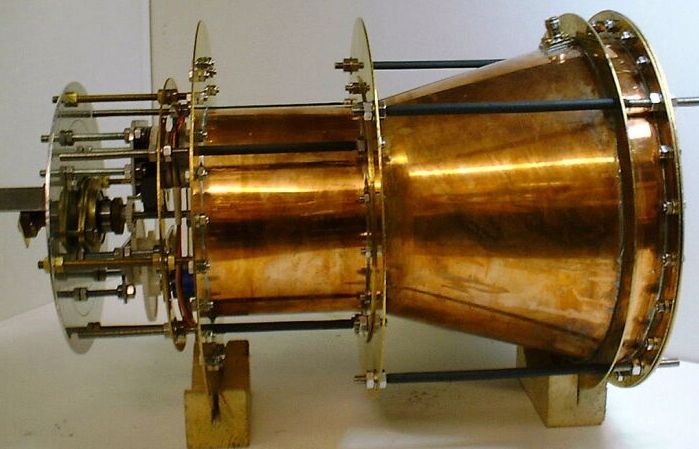'Impossible' EmDrive Space Thruster May Really Be Impossible

The laws of physics have won again, it would appear.
For the past few years, researchers at NASA's Eagleworks advanced-propulsion lab have been putting a controversial and potentially revolutionary space engine called the EmDrive to the test.
The EmDrive, which was originally developed by British scientist Roger Shawyer in the early 2000s, purportedly generates thrust by bouncing microwaves around inside a conical chamber. Because the engine doesn't require any fuel, it could theoretically make spaceflight far cheaper and more efficient, opening the heavens to exploration. [Superfast Spacecraft Propulsion Concepts (Images)]
And the NASA team's work has given EmDrive enthusiasts some reason for optimism, detecting small amounts of thrust in lab tests of the device.
But now we get to the "controversial" part: The EmDrive really shouldn't work. The engine doesn't blast anything out a nozzle, so Newton's Third Law of Motion — for every action there is an equal and opposite reaction — doesn't come into play. Nobody really understands how the claimed thrust could actually be generated.
And now it seems that the previously detected thrust was illusory, at least according to a team of researchers in Germany. They built their own EmDrive and tested it in a vacuum chamber, as the NASA researchers did.
The German team picked something up as well. But follow-up analysis "clearly indicates that the 'thrust' is not coming from the EmDrive but from some electromagnetic interaction," the researchers wrote in their new study, which you can read here. That interaction is likely between EmDrive power cables and Earth's magnetic field, the team concluded.
Get the Space.com Newsletter
Breaking space news, the latest updates on rocket launches, skywatching events and more!
The German team, which was led by Martin Tajmar of the Institute of Aerospace Engineering at Technische Universität Dresden, also presented its results last week at the Space Propulsion 2018 conference in Seville, Spain.
The new results probably won't be the last word on the EmDrive; other researchers may want to take a crack at it as well. But if you've been counting on this impossible engine to help humanity get out among the stars, you may want to recalibrate your expectations.
Follow Mike Wall on Twitter @michaeldwall and Google+. Follow us @Spacedotcom, Facebook or Google+. Originally published on Space.com.
Join our Space Forums to keep talking space on the latest missions, night sky and more! And if you have a news tip, correction or comment, let us know at: community@space.com.

Michael Wall is a Senior Space Writer with Space.com and joined the team in 2010. He primarily covers exoplanets, spaceflight and military space, but has been known to dabble in the space art beat. His book about the search for alien life, "Out There," was published on Nov. 13, 2018. Before becoming a science writer, Michael worked as a herpetologist and wildlife biologist. He has a Ph.D. in evolutionary biology from the University of Sydney, Australia, a bachelor's degree from the University of Arizona, and a graduate certificate in science writing from the University of California, Santa Cruz. To find out what his latest project is, you can follow Michael on Twitter.









